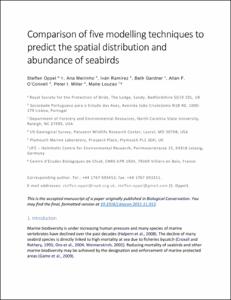| dc.contributor.author | Oppel, Steffen | |
| dc.contributor.author | Meirinho, Ana | |
| dc.contributor.author | Ramírez, Iván | |
| dc.contributor.author | Gardner, Beth | |
| dc.contributor.author | O’Connell, Allan F. | |
| dc.contributor.author | Miller, Peter I. | |
| dc.contributor.author | Louzao, Maite | |
| dc.date.accessioned | 2022-03-08T15:25:36Z | |
| dc.date.available | 2022-03-08T15:25:36Z | |
| dc.date.issued | 2012 | |
| dc.identifier.citation | Oppel S., Meirinho A., Ramirez I., Gardner B., O'Connell A.F., Miller P.I. and Louzao M. (2012) Comparison of five modelling techniques to predict the spatial distribution and abundance of seabirds. Biological Conservation, 156, pp.94-104. DOI: https://doi.org/10.1016/j.biocon.2011.11.013 | en_US |
| dc.identifier.uri | https://repository.oceanbestpractices.org/handle/11329/1889 | |
| dc.description.abstract | The number and complexity of modelling techniques used to predict species distributions has
increased substantially over the past decades (Hegel et al., 2010), and several comparisons of
model performance have been carried out for terrestrial species (e.g., Elith and Graham, 2009;
Elith et al., 2006; Segurado and Araújo, 2004). In contrast, the marine environment is less
studied and more challenging given its dynamic nature (Ready et al., 2010; Robinson et al.,
2011; Wakefield et al., 2009). Furthermore, seabirds are highly mobile species, and their
presence at certain locations varies temporally depending on whether an area is used during
the breeding season, as a migration stopover, or as moult refuge (Tremblay et al., 2009). A
comparison of the performance of different models that predict distributions and abundances
of seabirds based on shipboard survey data has to our knowledge only been explored for one
coastal species (Yen et al., 2004), yet the bourgeoning interest in the identification of pelagic
marine protected areas warrants a comparison of newer distribution modelling techniques. Here we compare the performance of five modelling techniques to predict the occurrence and
abundance of a migratory seabird species outside of the breeding season. The Balearic
Shearwater (Puffinus mauretanicus) is a critically endangered species that breeds only at the
Balearic archipelago in the western Mediterranean, and migrates to the North-East Atlantic
after the breeding season (Brooke, 2004). The species suffers from high adult mortality at sea
(Oro et al., 2004), and most research efforts have focused on understanding foraging ecology
and distribution during the breeding season in the Mediterranean (Bartumeus et al., 2010;
Louzao et al., 2006a, 2006b). Marine protected areas are needed for Balearic Shearwaters
throughout its range, and although both Spain and Portugal have delineated marine important
bird areas (IBAs, Arcos et al., 2009; Ramírez et al., 2008), most of these areas were still not
legally protected as of October 2011 (BirdLife Inter-national, 2010a).
Our model comparison aims to inform seabird conservation managers about the performance
of modelling techniques that can be used to predict the spatial distribution and abundance of
seabirds for the identification of marine IBAs or protected areas. We tested model predictions
against independent data and com-pared predicted distributions with the locations of existing
marine IBAs to evaluate whether our model results agree with IBAs that were identified with a
variety of different methods (Ramírez et al., 2008). Thus, we provide information on which
modelling techniques are useful for seabirds, and identify areas that may war-rant protection to
benefit the Balearic Shearwater. | en_US |
| dc.language.iso | en | en_US |
| dc.subject.other | Modelling | en_US |
| dc.subject.other | Seabirds | en_US |
| dc.title | Comparison of five modelling techniques to predict the spatial distribution and abundance of seabirds. | en_US |
| dc.type | Journal Contribution | en_US |
| dc.description.refereed | Refereed | en_US |
| dc.format.pagerange | pp.94-104 | en_US |
| dc.identifier.doi | https://doi.org/10.1016/j.biocon.2011.11.013 | |
| dc.subject.parameterDiscipline | Birds, mammals and reptiles | en_US |
| dc.subject.dmProcesses | Data processing | en_US |
| dc.bibliographicCitation.title | Biological Conservation | en_US |
| dc.bibliographicCitation.volume | 156 | en_US |
| dc.description.sdg | 14.a | en_US |
| dc.description.eov | Marine turtles, birds, mammals abundance and distribution | en_US |
| dc.description.ebv | Species distributions | en_US |
| dc.description.ebv | Species abundances | en_US |
| dc.description.methodologyType | Reports with methodological relevance | en_US |
| obps.contact.contactname | Steffen Oppel | |
| obps.contact.contactemail | steffen.oppel@rspb.org.uk | |
| obps.resourceurl.publisher | https://www.sciencedirect.com/science/article/abs/pii/S0006320711004319?via%3Dihub | |
 Repository of community practices in Ocean Research, Applications and Data/Information Management
Repository of community practices in Ocean Research, Applications and Data/Information Management
